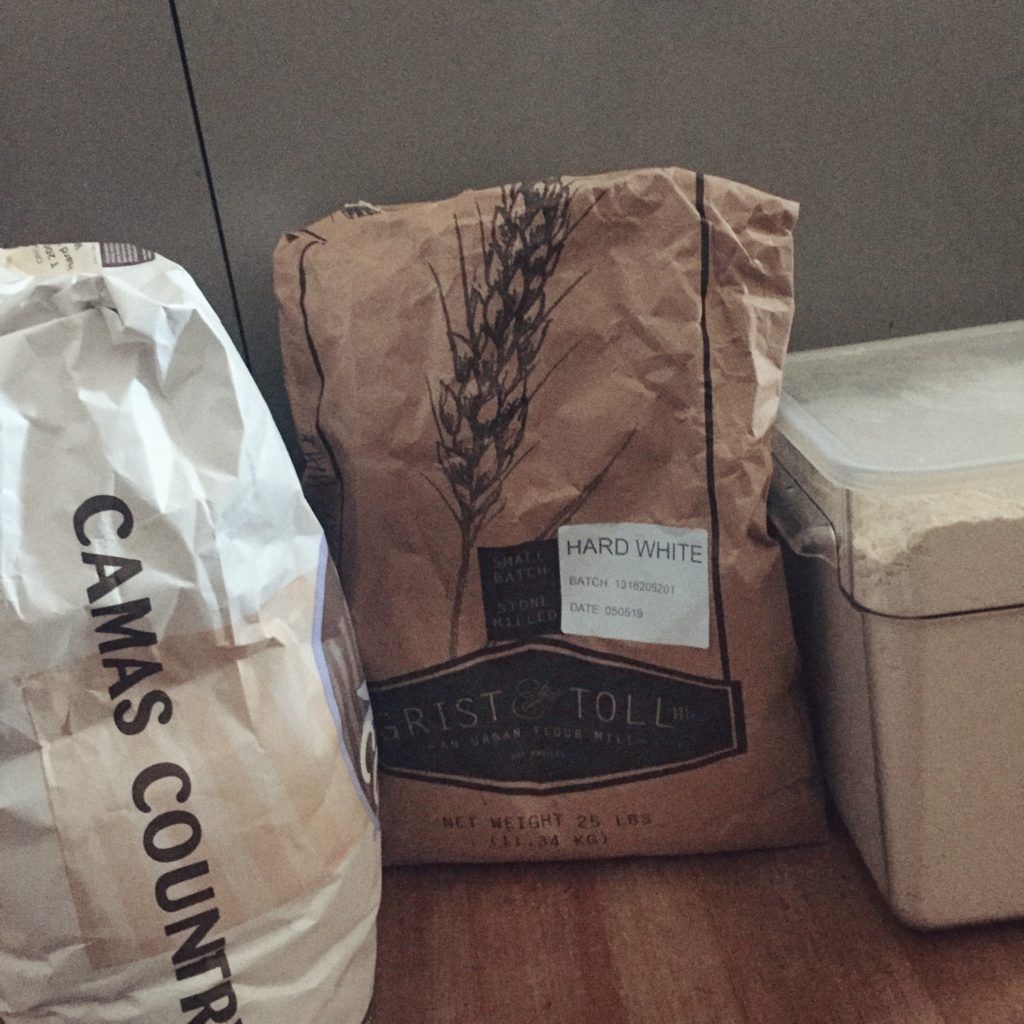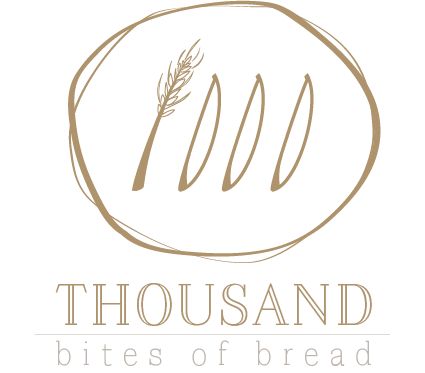
I talk a lot about flour here on this site, but I don’t want that to be a mere list of what I’m putting into my bread. I want you to understand flour and how it comes from a cereal grass seed and how millers crush that seed down into powder, or how they break it apart into component pieces first and then pulverize those pieces, and put it back together (or not).
Whole Grain Stone-Milled Flour
Some millers, like Nan Kohler of Grist & Toll in Pasadena, choose to produce whole grain flour that is made in a slow, stone-milling process. This technique keeps the grains cool so less of the nutrients are damaged. Flour made this way is truly whole grain—everything that goes into the hopper of the mill comes out as flour. This way of milling preserves the inherent flavor, as well as the whole nutritive properties of the grain.
I love baking with this kind of flour; it is, in fact, the same kind of flour I produce at home (although not quite as good since I haven’t dedicated my life to being a miller of excellence like Nan). My favorite places to purchase this flour on-line are Grist & Toll, Carolina Ground, Maine Grains, Camas Country Mill, Barton Springs Mill, Meadlowlark Organics, Bluebird Grain Farms (they use a hammer mill), and Bellegarde. Bob’s Red Mill has stone ground flour that is widely available, but sometimes they keep it on the shelf a long time (up to a year), so check the milling date on the bag.
White Roller-Milled Flour
On the other end of the spectrum is a kind of flour that is taken apart into components—namely bran, endosperm, and germ. Once it is broken into parts, millers often only grind the endosperm, since that is the white part of the flour believed to be most desirable for the past hundred years or so. This means the bran and germ are often left out. This way of making flour gives the miller more control over the finished product and was created to streamline the production of flour. It came about during the industrial revolution, solving many issues of the day. For one, millers can leave out the part that is not shelf stable (the germ). But that brings up a key point: roller milling takes away intrinsic nutrition. Whole grains are packed with vitamins and minerals and phytochemicals that are taken out when we make white flour. Some millers add back a few B vitamins and one mineral (iron). This is called ‘enrichment’ and was added to flour starting in the 1940’s as a public health measure. Enrichment doesn’t add back any of the fatty acids, phytonutrients, or fiber.
White flour is part of a food, rather than a whole food. But obviously, there is a place for it. I enjoy croissants and bagels made with white flour (although I love them even more made with the flour I write about below); that said, I don’t see them as an everyday choice for nourishing myself and my family. I want you all to know right now that this is not a personal attack on whatever you choose. Nor is it some declaration that white flour is the devil (I don’t, in fact, believe in the devil. Haha.) I just want you to have all the information so you can make your best-informed choices. There are a few larger mills that get my vote for keeping the grain economy healthy and flourishing, even if their main flours are roller-milled, white flours, which is not my everyday choice (but is the everyday choice of many bakers, so…) When I choose white flour, I get the ones made by Cairnspring Mills, Central Milling, King Arthur, and Lindley.
Sifted Flour (sometimes called high extraction flour)
So…where are we? You now know what whole grain flour is, and you also know what white flour is. Kind of between the two, there is something else: Sifted flour.
One of the most misunderstood flour choices is that of sifted flour, or what some people call bolted or high-extraction flour, and others refer to as triple-sifted, or even ‘OO’. The problem is that there’s no uniform nomenclature in the industry, so millers are left to their own devices in trying to relay to consumers what they are buying.
Let me backtrack to my own story:
I decided some years ago that I wasn’t going to stock my kitchen with standard roller milled flour. My reason for this is because I was on a quest to use food as the building blocks of health for my family, and although all purpose flour can make really delicious bread, there is a lot of nutrition inherent in wheat that is taken out in the process of roller milling (see above). I was mostly baking with whole grain flours, as I talked about above, but you see, my family sometimes asked me to make white sandwich bread, and I wanted to make it because I like seeing smiles on their faces. Pleasure is a nice ingredient, too.
Was white flour my only choice?
I knew that before the manufacture of roller-milling was invented, some people would lighten their flour (or have their house servants lighten their flour) by sifting through cloth the flour they produced by stone-milling. Processed this way, flour could only be reduced by particle size, rather than part. This meant that all of the bran, endosperm, and germ were ground together whole and then only the big pieces were sifted off.
In this way of making flour, yes, some of the large particles are taken out. But from what I could tell—since the grain is crushed whole—some of the small pieces of fiber and many of the nutritious parts pass through the sifters. Remember, roller-milled white flour doesn’t have this capability because they crack those parts off before even getting to the operation of milling.
And guess what? I was thrilled to learn that a few millers are doing this kind of flour again! A few that I can think of off the top of my head are Carolina Ground’s AP 85, which means that 85% of the whole grain was sifted through and 15% of the mostly bran was sifted off; Similarly, Hayden Flour Mills does the same 85% process to all of their flours, except their ’00’, which is sifted a bit more. Camas Country Mill makes a flour the same way called T200, meaning the stone ground flour has gone through three sifters that are 200 microns each; There’s also Maine Grains Organic Sifted Wheat Flour, Stone Ground, which is a mouthful, but more straightforwardly named.
Some thoughts
In my family, we try to eat whole grain flour as often as we want, while we save white flour for rare occasions when we absolutely want that donut no matter what, just because. Sifted flour sits somewhere between the two; we eat it more often, but not every day.
Look, I’m not here to vilify white flour or judge what you eat. You don’t need me to make disclaimers about the fact that I’m privileged enough to have choices about what I eat…most of us have some choice about what we eat. I’m simply taking you through my own process of choosing.
It’s just that if wheat is a savings account of possible health, roller milling removes most of the growth potential. Do you understand what I’m saying? There is nothing “bad” about wheat; it’s just that what most people eat is not really wheat, but only endosperm—the refined sugar bomb part of the wheat. Many all-purpose flours are enriched with synthetic vitamins to make up for this. It’s a public health measure, I get it. But public health and individual health are different things when weighing our choices for optimal nourishment.
It seems unwise to me to take out the part of the grain that intrinsically has B vitamins, phytochemicals, and fatty acids, only to put back in a fraction of compromised versions of the same. Anyway…
Here’s what’s on the menu this week:
Mama Bread
This week’s Mama bread is made with Star white whole wheat from Grist & Toll. These loaves have amazing aroma and voluminous rise. A million thanks to Nan for this amazing flour! See above.
Organic Sandwich Loaves
The sandwich bread this week is made with organic triple-sifted Edison flour from Camas Country Mill. We are lucky here in Oregon to have such a mill that grows local grains and produces a quantity of high-quality flour. They are not the only game in town, but they do provide a good backbone for many of the local bakers here.
100% Einkorn Loaf
Einkorn is the most ancient wheat that we still cultivate. It’s genetically different than modern wheat because it reflects the time when wheat had a simpler DNA profile. It does not provide bread with the strong risen quality that modern wheat does, but it’s full of flavor and nutrition. I’m using grains from Bluebird and milling them at home on my Komo. I’m making this bread as a pan loaf and it’s superb toast dripping with butter and a shaving of parmesan cheese.
Fig & Walnut
I was craving a bread packed with fruit and nuts, and this one is it. Loaded with organic mission figs and plump walnuts, I also dusted this one with a good amount of cinnamon to satisfy my sweet tooth. I love this bread with a thick slab of butter and a drizzle of honey. Even better if you serve this alongside funky cheese.
To place an order, email me to let me know what you want and what day in the coming week you would prefer to get it. You are always welcome to drop by for espresso & morning toast, or we can work out delivery or pick-up via email. I have a limited amount of each item, so the earlier in the week you let me know, the better your chances of getting what you want. For the more spontaneously-minded types, drop me a line whenever and I’ll let you know what I have on hand. Oh, and if you want to pay for the bread on-line, here is the link. Of course, I’m always open to trade…
Savor your week with madcap delight and untamed gratitude,

Other news from the world of grain:
-If you don’t know about the sourdough library in Belgium, you can have a blast seeing these short movies that tell the stories of sourdough cultures gathered from all over the world. What a blast it was meeting @the_sourdough_librarian
-If you like podcasts and bakers, I highly recommend Rise Up! It’s hosted by Mark Dyck and he’s dedicated to telling the stories of people in the bread world. He’s recently interviewed many of my friends, and even though I know them, I learn something new each time I listen. Very fun!
-And while we’re on the topic of podcasts, have you heard the Sourdough Podcast episode with Sarah Owens. Check it out!
